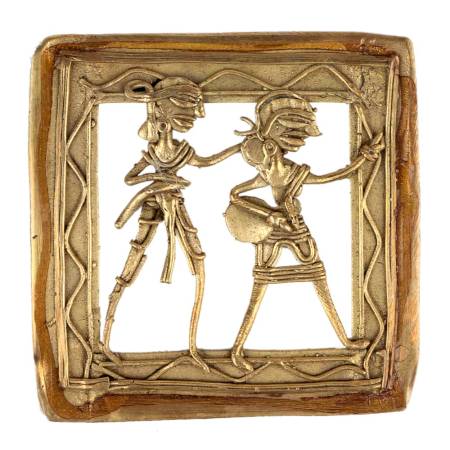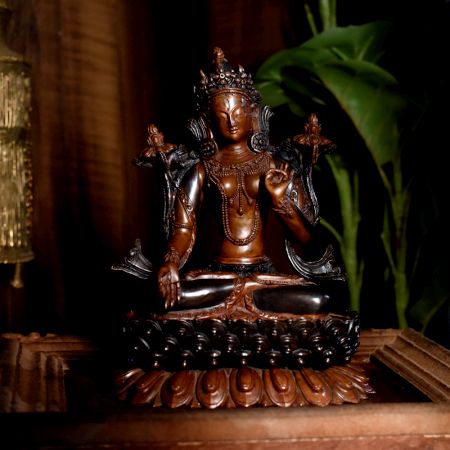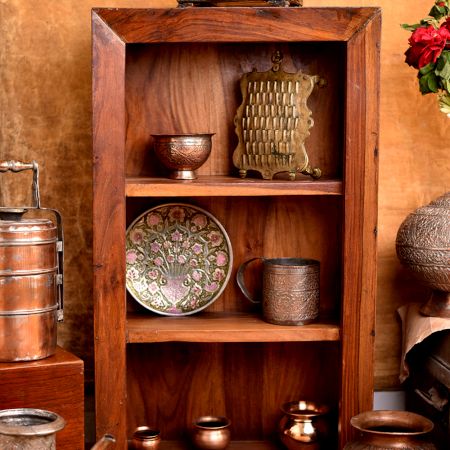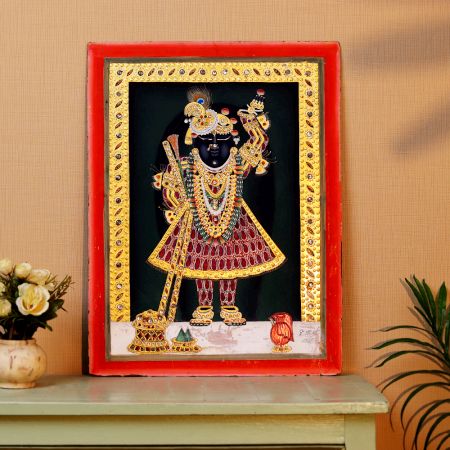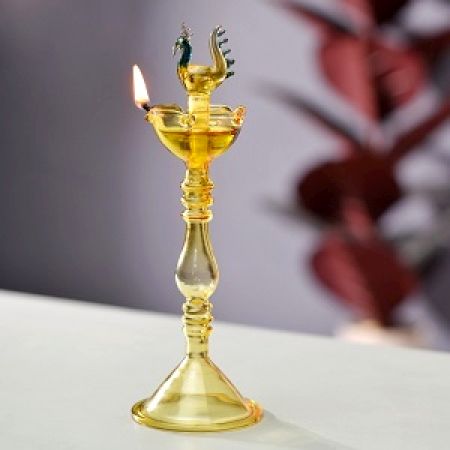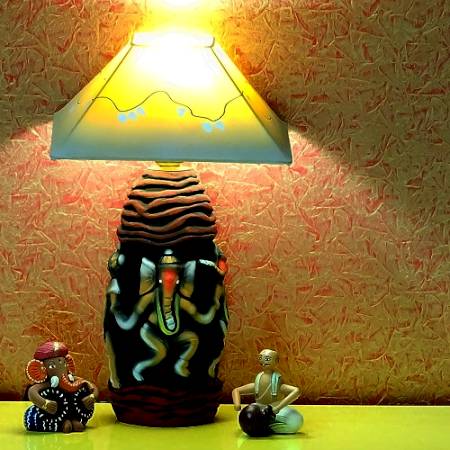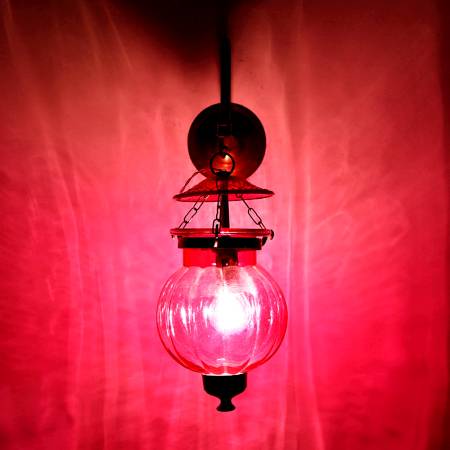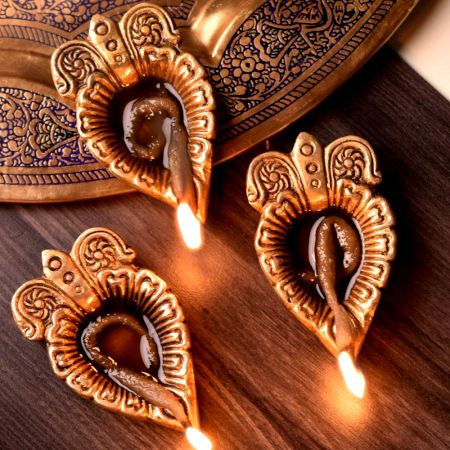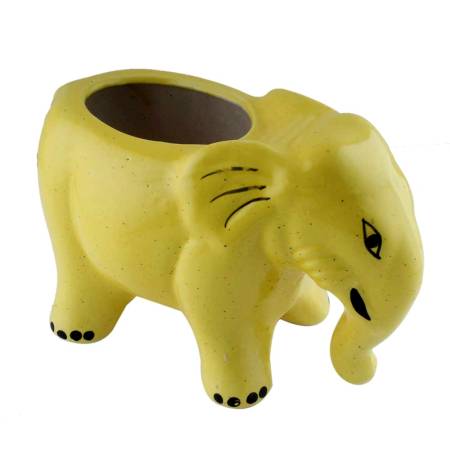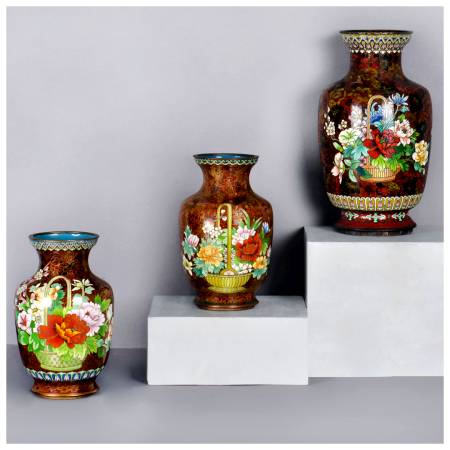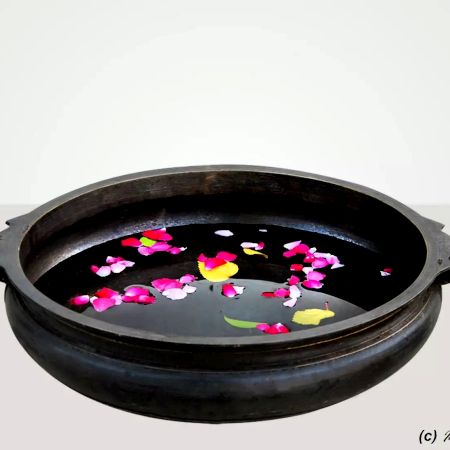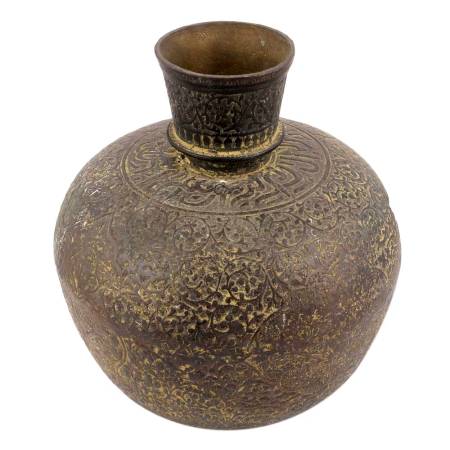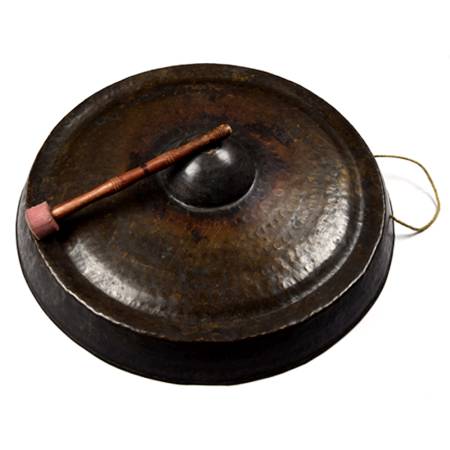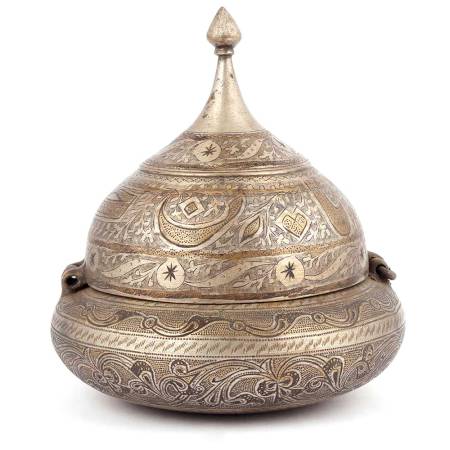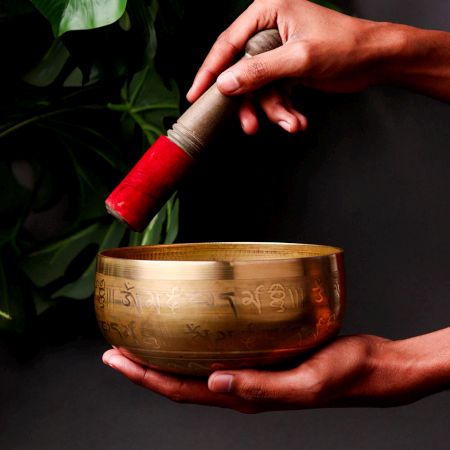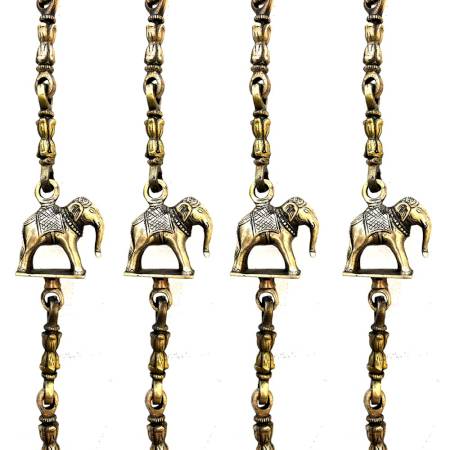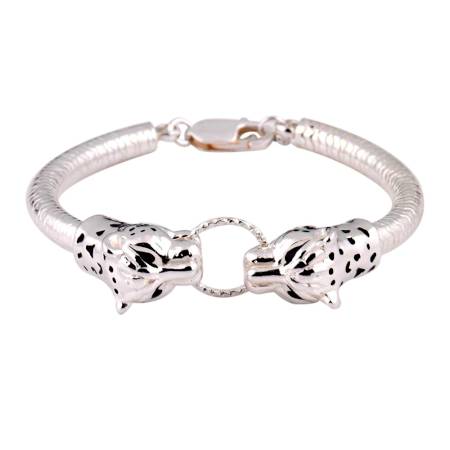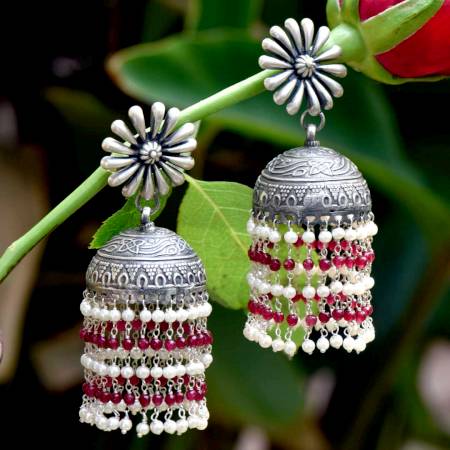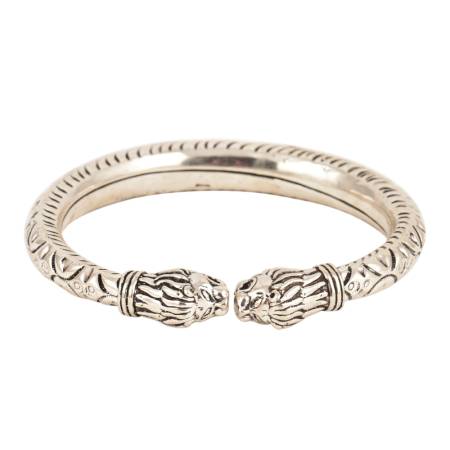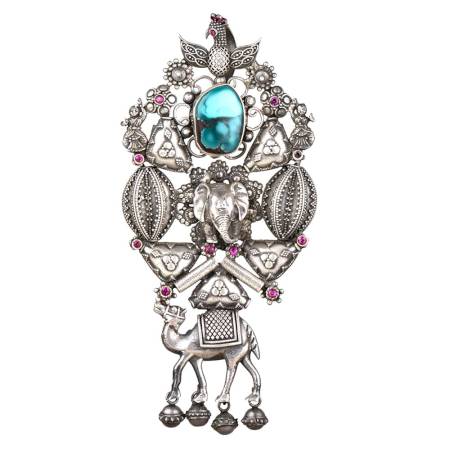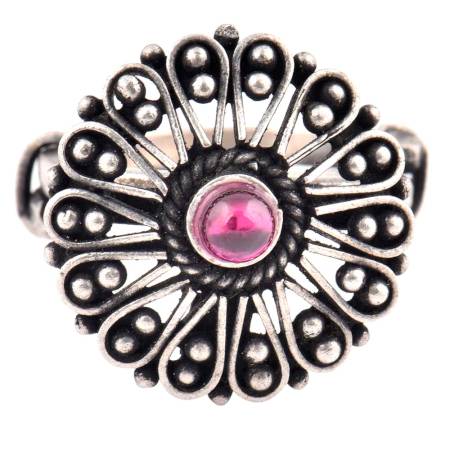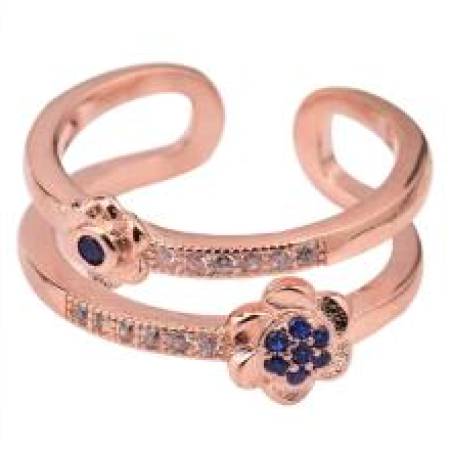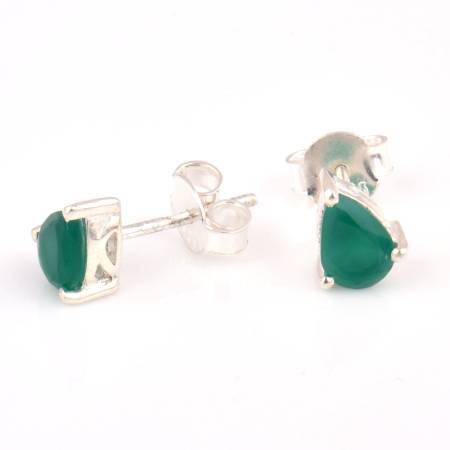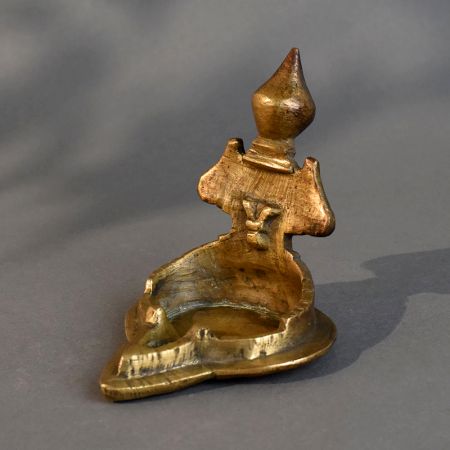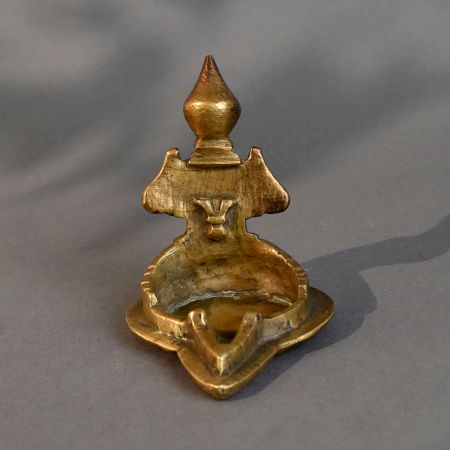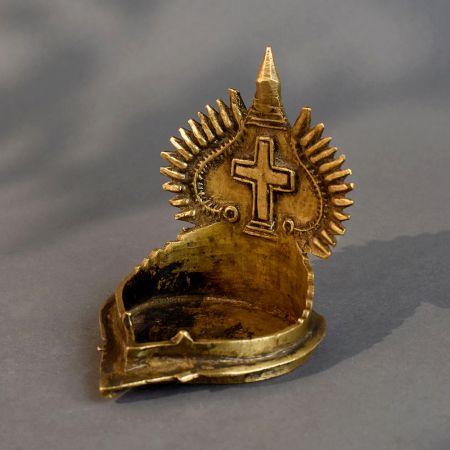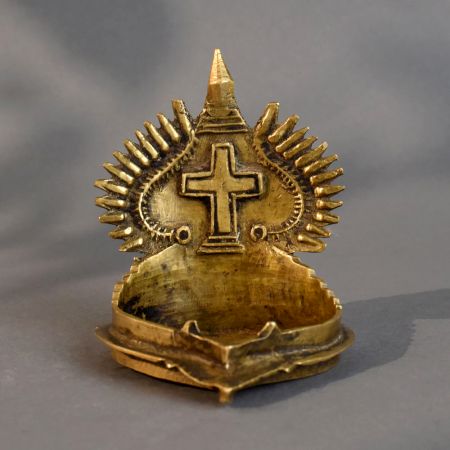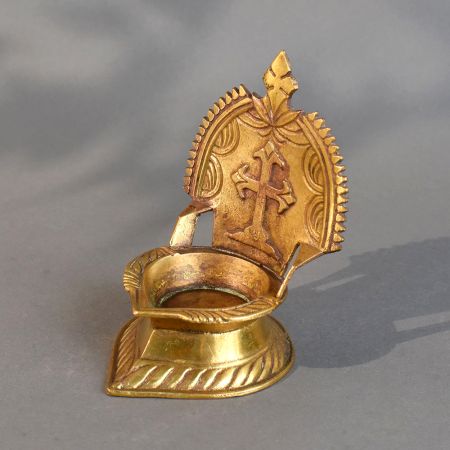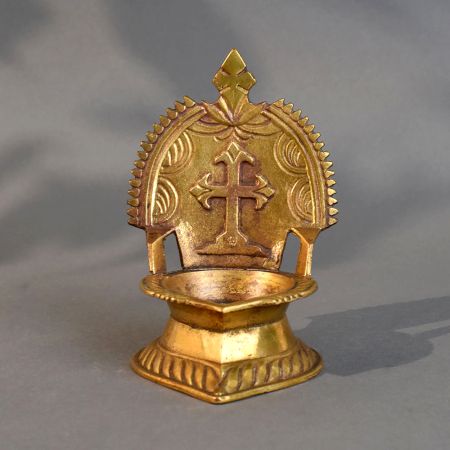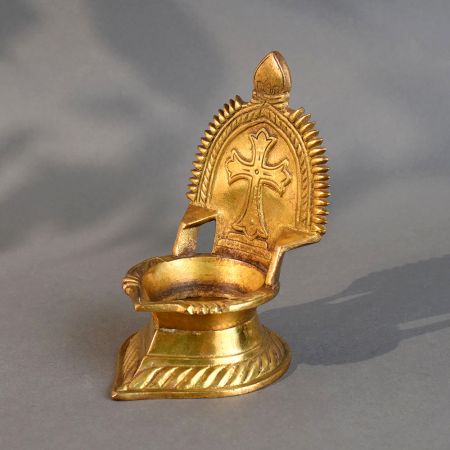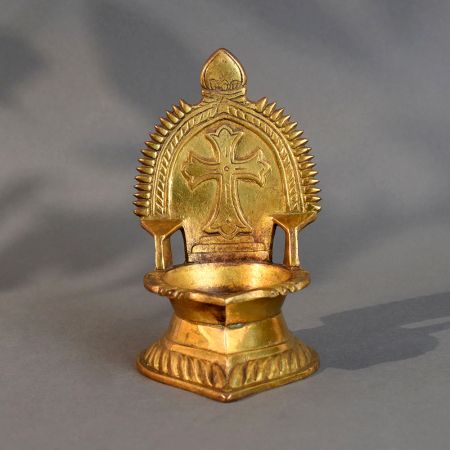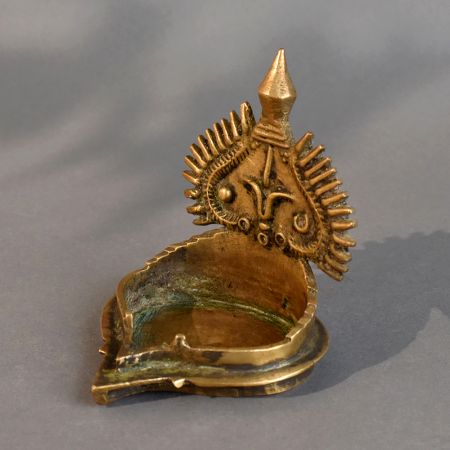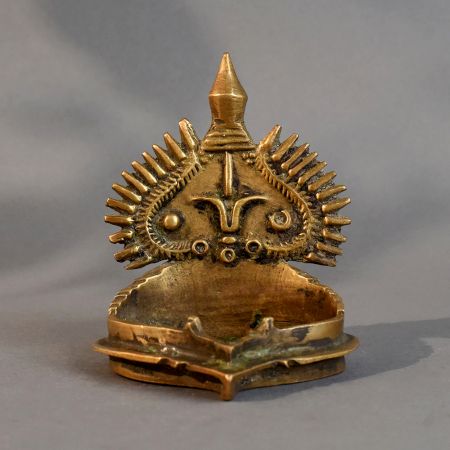Buy Kamatchi Vilakku and Kamakshi Deepam Online
General Understanding of Kamatchi Vilakku
In the quiet hum of a household or the echoing halls of a temple, Kamatchi Vilakku stands unwavering, a vessel of light, both literal and eternal. It is not just an object, it is presence. Crafted in gleaming brass or bronze, it cradles flame like a mother holds her child, fierce in protection, gentle in glow. The form evokes balance, the kind that tilts toward grace. It doesn’t shout for attention, it simply exists with purpose. It asks nothing. Yet it gives, a space to pause, breathe, surrender. An ancient design that continues to whisper relevance in every corner it touches.
What Is A Kamatchi Vilakku?
A Kamatchi Vilakku is not a lamp in the decorative sense, it is a structure of sanctity. Rooted in South Indian spiritual practice, it holds the feminine divine not as a symbol, but as a seated reality. The form typically represents Goddess Kamakshi, her features cast with reverence into brass or bronze. This lamp isn’t just lit, it’s invited. Lighting it is a gesture, a conversation between the self and the unseen. It often sits on home altars or temple corners, its very shape a script of devotion. The flame it holds is believed to dispel not just darkness but despair. Its design is precise, there’s a reason behind every curve, every lotus, every outstretched hand. It’s an object carved with intention, carrying thousands of years of mythology, memory, and meaning within its metallic skin.
What Emotions Or Themes Do Kamatchi Lamps Commonly Portray?
Kamatchi lamps speak the language of stillness. They don't just portray emotions, they hold them, like sacred keepsakes passed through generations. Peace isn’t just represented, it settles in the room once the flame is lit. They evoke maternal assurance, the kind that doesn't require words. Abundance glows in the slow, quiet burn of ghee. Protection lies in the very weight of the lamp, in how it anchors a space, how it claims presence without force. Themes of fertility, surrender, cyclic renewal, all flow from its core. It doesn’t scream spirituality. It breathes it. This lamp is not an accessory, it’s a soft guardian. A symbol of inner calm, a reflection of cosmic rhythm, and above all, a reminder that sacredness can have a form, a weight, a glow, and a place to stand.
What Are The Most Recognized Styles Of Kamatchi Deepam?
Kamatchi Deepams come in styles that do not differ for the sake of design, but for the sake of devotion. The most revered versions feature the seated form of Goddess Kamakshi, often with her hands held in blessing or meditative posture, flanked by lotus motifs, floral vines, and sometimes peacocks. Temple-style lamps are grand, tall, anchored, meant for ritual gravity. Home altar variants are more compact, intimate, carrying the same essence in smaller proportions. Some carry carvings across the base, others feature a canopy above the deity, symbolizing the cosmic shelter. None are ornamental for ornament's sake. Each detail, be it the eye of the goddess or the arc of the base, serves to express something higher. The flame becomes secondary to the form, yet, paradoxically, the form exists solely to cradle the flame. That’s the paradox these lamps master so beautifully.
Why Are Kamatchi Lamps Still Revered In Contemporary Homes?
Modernity doesn’t erase memory, it reconfigures it. In contemporary homes filled with glass, chrome, and efficiency, Kamatchi lamps offer a stillness, a soul. Their appeal is not nostalgia, but necessity. People light them not just to remember tradition, but to reclaim ritual. The lamp becomes an anchor in a life untethered by screens, speed, and the noise of multitasking. Its presence is timeless not because it resists change but because it remains essential through change. It gives a home not just light, but pause. Even in minimalist spaces, it doesn’t feel out of place, it feels like a heartbeat. The reverence comes not just from religious belief, but from the emotional utility it offers, to begin the day, to end an argument, to mourn, to hope, to celebrate. In a world too fast to feel, Kamatchi Vilakku still teaches us how to hold space.
Techniques, Mediums & Craftsmanship
To create a Kamatchi Vilakku is not to manufacture, it is to consecrate. Each one begins in fire and ends in devotion. Artisans do not just make, they listen, to scripture, to lineage, to silence. The process is rooted in metallurgy, but shaped by myth. Lost wax casting breathes life into brass, while hands carve not just eyes and fingers, but expressions. The lamp is not complete once made, it becomes, slowly, as it is lit, as it is used, as it witnesses. Craft is married to meaning. Tools are extensions of belief. The material remembers heat, the form remembers purpose. No two are truly alike, for each is imbued not just with skill, but intention.
How Were Kamatchi Lamps Traditionally Created?
The creation process follows ancient rhythm. Lost wax casting, an age-old technique, is central. It begins with a clay or wax model, shaped to precision, often by hereditary artisans trained not only in skill but in philosophy. This model is coated, fired, and then filled with molten metal, usually brass or bronze. Once cooled, it is broken free from the mold, a kind of rebirth. Then begins the detailing, chisels and files slowly shape features, curves, and iconography. Unlike machine-produced decor, this is a slow process, guided more by devotion than speed. For artisans, this isn’t just craftsmanship, it’s a prayer. Each lamp is tuned to proportions believed to reflect cosmic geometry. Even the seat of the goddess, the fold of her sari, the length of the base, everything follows scriptural blueprints. The final product carries both artistic lineage and spiritual weight. It's not a product. It's a process, remembered in metal.
What Materials Were Commonly Used In Their Making?
The body remembers what the hands once touched. In the case of Kamatchi lamps, brass and bronze carry that memory. Brass, with its sunlit sheen, reflects light brilliantly, while bronze, darker and denser, holds warmth like a womb. Both metals are chosen not just for durability, but for how they react with fire, how they age, how they retain sacredness. In some traditions, panchaloha is used, a five metal alloy believed to capture elemental energies. These aren’t random choices. Each material has energy, resonance, and lore. Some lamps are rubbed with turmeric, others with ghee, adding layers to their skin, rituals that go beyond maintenance. The material isn’t just functional, it’s part of the spiritual contract. It bears weight, not just of form, but of faith.
What Role Did Base Materials Like Wood Or Stone Play?
While the lamp itself remains metal, its base, where it rests, carries its own gravity. Wood, especially neem or teak, offers a grounding touch, a softness to balance the metal’s stoic gleam. It doesn’t just hold the lamp, it frames it. In temples, stone bases often elevate the lamp, both physically and symbolically. Stone provides permanence, the kind that doesn’t move with trends. It speaks of earth. In some cases, these bases are carved with yantras or sacred patterns, aligning the lamp to energy centers. The base, though often overlooked, is crucial. Just like a temple needs a sanctum, a lamp needs ground. It’s not about height, it’s about harmony. The base ensures the flame doesn’t just rise, but roots itself. A spiritual balance, between the anchored and the ascending, the held and the lit.
Artistic Intent and Visual Storytelling
Kamatchi lamps aren’t mere objects. They’re symbols. Crafted with devotion, they hold stories within their metal, stories of generations, rituals, festivals, and moments of silence. The lamp becomes a shrine of motionless light, constantly flickering but never wavering. Its glow doesn’t just illuminate a room, it expands the soul. These forms are not for decor. They’re for remembrance, for anchoring the intangible. A Kamatchi Vilakku is a witness to prayers unanswered, hopes rekindled, and faiths restored. Its structure isn’t for show. Every design, curve, and petal serves a higher function to convey, to guide, and to bless.
What Messages Or Meanings Do Kamatchi Lamps Aim To Convey?
The Kamatchi lamp speaks softly but deeply. It conveys the supremacy of light, not just as illumination, but as guidance. Each time it’s lit, it marks a beginning, of a day, a ritual, a prayer. It stands as a symbol of protection, the unseen aura that shields homes from chaos and imbalance. The feminine form, drawn into its very shape, conveys creation, nurturing, and sustenance. It blesses not by grand gestures but by quiet presence, reminding us that even stillness holds power. Lighting this lamp isn’t a task. It’s an offering. To the divine, yes, but also to the self.
How Did Artisans Encode Political, Spiritual, Or Cultural Symbols?
The body of a Kamatchi lamp is more than metal. It is a manuscript. Each curve holds metaphors, each motif has ancestry. The lotus base isn’t chosen for its beauty alone, it denotes spiritual awakening, a soul blooming in murk. The presence of deities, animals, and symmetrical carvings recall temple pillars and the architecture of ancient faith. In times of suppression, artisans wove resilience into design, subtle symbolism that resisted erasure. Caste, region, goddess lineage, everything found a place. These were not just craftspeople. They were storytellers under monarchs, colonialism, and modernity. They embedded belief systems where words weren’t allowed.
How Do Light, Shadow, And Flame Shape The Lamp’s Aura?
Light in a Kamatchi lamp is never just functional. It’s emotional. When the wick burns steady, it invites calm. When it flickers, it converses. The shadows cast by its base stretch across walls like blessings in motion. Flame dances, yes, but with memory, with intent. It breathes through rooms, fills them with warmth that isn't temperature but temperament. The glow changes mood, tone, and inner rhythm. It speaks in silent vocabulary, warmth, focus, presence. You don’t just light it. You allow it to take space. It’s how walls become sacred, how thresholds become temples, how moments become still.
Purchase, Collection and Investment
To own a Kamatchi lamp is to inherit more than metal. It’s to carry meaning. While modern decor shifts with trends, these lamps stay rooted, offering continuity. Collecting them is less about materialism and more about memory making. You’ll find them in temple markets, old towns, handloom melas, and even homes where time moves slower. Their worth lies not in price tags but in presence. Online platforms have begun to archive and preserve them, but the soul remains in the hands that craft it. Owning one is not just collecting. It's choosing to be part of a much larger, older story.
Where Can You Buy Authentic Or Artistic Replicas?
Authentic Kamatchi lamps are usually found where stories breathe, in temple towns, heritage bazaars, and craftspeople clusters across Tamil Nadu, Kanchipuram, and Madurai. Artisan exhibitions and craft festivals like Dastkari Haat or Surajkund Mela are ripe with genuine finds. If you’re exploring online, platforms like IndianShelf work directly with rural craftspeople, not mass production hubs, offer curated replicas that retain soul. Avoid synthetic shine, true pieces are often matte, slightly imperfect, and heavy with presence. Sometimes, the best ones are inherited or found hidden in a grandmother’s trunk. Trust your eyes, but trust the feeling they give you more.
How Can You Verify The Authenticity Of A Piece?
Authenticity is in the details. Examine the balance, authentic ones stand still, grounded. Observe the carvings, they’ll be deep, intentional, not etched like a print. Genuine lamps carry weight, not just physical but energetic. Many carry hallmark stamps or identifiers from crafts councils, but even without that, the visual texture, color oxidation, and proportion will speak. Look for wear that comes from time, not polish. If it feels like it’s always been there, it probably is real. Engage the seller, ask who made it, where, how. Authenticity isn’t in a label. It’s in how the lamp makes you pause.
What Makes Kamatchi Deepam A Worthwhile Heirloom?
Heirlooms aren’t measured in price. They’re measured in presence. A Kamatchi lamp, once lit by an elder, carries that energy across generations. It remembers. Its flame holds years of rituals, mantras, births, and losses. You don’t pass it on because it’s old. You pass it on because it’s sacred. Its metal may dull, but its aura sharpens. It teaches reverence, consistency, and surrender. Each time it moves homes, it carries an unspoken blessing. When you place it in your space, it’s no longer just yours. It becomes a part of your story, and you, a continuation of someone else’s.
Care, Framing and Preservation
Care isn’t maintenance. It’s devotion. The Kamatchi lamp isn’t to be dusted like decor. It’s to be tended like memory. Natural cleaners, tamarind, lemon, ash, don’t just clean, they purify. The act of polishing is ritual itself. Where you place it matters, wood, stone, or brass bases create respect around it. It shouldn’t blend in, it should rise. With time, its glow may fade, but with effort, it returns. Cracks, dents, tarnish, they’re not flaws, they’re signatures of use. Preservation doesn’t mean making it new. It means keeping its story alive. Like all sacred things, it ages with grace if held with grace.
How Do You Properly Maintain A Kamatchi Deepam?
You clean it not just to make it shine, but to keep its spirit clear. Natural agents like tamarind paste, lemon, and cow dung ash are traditional and respectful. Avoid synthetic polishers, they strip more than they clean. Post cleansing, use cotton cloths to wipe, and oil the wick holders to prevent drying or cracking. Don’t leave oil residues for long, they attract dust and reduce longevity. When not in use, wrap it in soft cotton or place in a wooden box. Think of it as preparing a body for rest. Light it often, it stays alive when used, not shelved.
What Stands Or Setups Best Complement Their Look?
Kamatchi lamps deserve grounding. Wood bases especially teak or rosewood bring out warmth. Stone tiles especially granite or soapstone anchor its spiritual pull. Brass thalis underneath add reflective harmony. Elevate them slightly, never place them directly on cold floors. If indoors, create a space, a niche or a shelf that invites silence. In outdoor settings, place them against natural textures like brick or earth. Minimal surrounding elements work best, this lamp doesn’t need attention, it draws it. The setup isn’t to showcase it but to respect it. Let its presence echo, not get lost. It’s the heart, not the frame, that must be seen.
Can Aged Lamps Be Restored Without Losing Their Energy?
Yes, but gently. Restoration doesn’t mean making it look new. It means helping it breathe again. Avoid heavy scrubbing or machine polishing. Instead, soak it in warm water with tamarind or lemon, then wipe by hand. Avoid harsh brushing over deity faces or floral engravings. If it's cracked, consult traditional metal artisans, not welders. Restoration isn’t mechanical, it’s ritualistic. Sometimes, it's better to leave a mark, a dent, a dark patch, it’s a memory. Energy doesn’t lie in shine. It lies in use, in prayers offered, in times remembered. Revive it only enough for it to continue living, not to forget where it came from.
What Common Issues Arise Over Time?
Tarnishing is natural, it’s the lamp exhaling. Dents happen when we stop treating it like presence and start treating it like object. Corrosion usually occurs when oil is left stagnant, or when the lamp is left wet for long durations. Sometimes the wick holders get jammed, or the base wobbles due to rough storage. These aren’t flaws, they’re calls for care. What the lamp needs is rhythm, a cycle of use, rest, and cleansing. The biggest damage? Neglect. A Kamatchi lamp doesn’t age poorly. It just waits. For hands to hold it, for flames to rise, for silence to return.
Home Decor, Styling & Mood Setting
Kamatchi lamps do not merely sit as ornaments on wooden shelves; they breathe presence into a room. Their placement becomes an act of intention. They don’t demand attention, they invite it. With soft flame and ancient form, they become an anchor in a world always shifting. They break the cold language of modern interiors with a whisper of brass and memory. Whether placed beneath an arch, beside a mirror, or on a quiet pedestal, they shape silence into sanctity. They are the kind of decor that doesn’t match a room, it transforms it. One glow at a time.
How Can Kamatchi Lamps Influence A Room’s Ambience?
A Kamatchi lamp changes the room not by overpowering it, but by softening its breath. The air feels different once it’s lit. The flame doesn’t just illuminate, it grounds. Its curves catch shadows. Its base remembers temple floors. In a cluttered world, it offers clarity. It marks a corner not as decorative, but as sacred. There’s something ancestral in the way its light touches walls, it tells you this is not just space, but a moment. For those who walk in, something shifts, their voice lowers, their spine straightens, their pause deepens. In a time of fast aesthetics and loud colors, this lamp introduces a quiet mood. It doesn't flash, it holds. In homes filled with artifice, it becomes the one thing that feels real. Not styled for a magazine, but for memory. Not curated, but kept. It teaches a room how to breathe slower.
What Interior Themes Pair Well With These Lamps?
Kamatchi lamps belong wherever stillness is respected. Ethnic corners filled with woven mats, carved furniture, and muted colors accept them naturally. In bohemian spaces, layered fabrics, handmade textures, they become the silent centerpiece. In heritage homes, they feel like something returned rather than something added. Even in minimalist environments, where less is sacred, the lamp thrives. A single brass deepam on a bare concrete shelf tells a story loud enough to echo. Temple-inspired interiors, high arches, warm woods, sacred geometry, are made for them. But what’s beautiful is how the lamp doesn’t beg for context. It creates its own. Place it beside a Tulsi pot, under a sepia-toned family photo, or in a study filled with books, it always finds a way to blend and bless. It doesn’t need space, it makes it. And in doing so, it changes how the room listens to itself.
How Do You Choose The Right One For Each Room?
The right Kamatchi lamp is less about design and more about resonance. In the living room, where guests gather and conversations echo, choose a bold piece, one that stands tall, proud, and layered with detail. Its glow becomes part of the welcome. In hallways, which are bridges between moments, use two smaller lamps, mirrored, minimal, but meaningful. Their symmetry adds rhythm to a silent walk. In the puja room or study, where focus or devotion dwells, choose a lamp that feels sacred with lotus motifs, spiritual inscriptions, or geometry that speaks of balance. Let the lamp be chosen not just for where it fits, but for what it does. Does it calm? Anchor? Inspire? That’s the only question. A lamp may be small, but if it carries memory, heritage, and intention, it can fill a room more than any furniture ever could.
Cultural Impact & Historical Legacy
The Kamatchi deepam is not merely old, it is continuous. From the sanctum of Chidambaram to the kitchen shelves of a grandmother’s home, its journey has been uninterrupted. It is passed, not purchased. It speaks of a time when flame meant worship and brass meant belief. Even today, it survives not as relic but as rhythm. Its presence is not explained, it is felt. It is one of the few things in a home that carries both weight and grace. It is not a product of trend but of trust. Its legacy is not in being seen but in being remembered.
What Is The Historical Significance Of Kamatchi Deepam?
The Kamatchi deepam is deeply rooted in the soil of Tamil spirituality and feminine divinity. It represents the living embodiment of Goddess Kamakshi, the one who sees with compassion and illuminates with grace. Historically, its use in rituals goes back to temple traditions, where lighting the lamp was not a custom, but a conversation between devotee and deity. Each deepam marked the beginning of the day, the silence before prayer, the soft call to inner order. In homes, it became the first flame mothers lit, and the last thing that flickered before sleep. Over time, it became a symbol of continuity, the thread that stitched generations. It did not merely light the altar, it held the memory of those who prayed before it. In every ritual, its flame was both a beginning and a return. Today, its relevance is not reduced, it’s simply recontextualized, still sacred, still lit.
How Did Different Regions Shape Their Aesthetics?
Every region gave the Kamatchi deepam its dialect, different, but bound by the same script. In Tamil Nadu, the form is robust, thick-bodied, with fierce facial expressions of the goddess, temple-like foundations, and towering crowns. It carries the echo of granite halls and Nadaswaram music. In Kerala, the shape softens, rounded petals, minimal designs, and a dance of curves. It feels closer to nature, coconut palms, open courtyards, silent prayers. Andhra Pradesh adds its intricacy, delicate vines, fine etching, and floral abundance that feels like spring held in metal. These aren't variations, they’re interpretations. Each region adds not just style, but story. And together, they build a geography of devotion. Across borders, the lamp adapts, but never loses its center. Like water taking the shape of the vessel, the flame remains unchanged. It burns with the same purpose, light for the goddess, light for the self.
Who Were The Influential Figures In Crafting Their Legacy?
Behind every Kamatchi deepam stands not just a god, but a hand. Generations of sthapathis, metalworkers, and spiritual teachers kept this form alive. Not for profit, but for prarthana. In temple towns like Kumbakonam, entire families have shaped metal into sacred memory. These artisans didn’t just make objects, they translated devotion into form. Then there were the gurus and spiritual leaders who taught why the lamp must be lit facing east, why the wick must split into five, and why the flame must never be blown out. They turned ritual into rhythm. Women too, in countless homes, became keepers of this legacy, lighting, cleaning, teaching, preserving. They made sure that the lamp wasn’t just a festival affair, but a daily act of grace. So this legacy isn’t authored by one. It is a chorus, sung by metal, hand, prayer, and flame, over centuries.
Sacred Lamps vs Other Decorative Items
There’s a silence that sacred lamps carry. Not the kind that fills space, but the kind that listens. Unlike modern decor which often follows trends and vanishes with seasons, these lamps don’t just blend in, they hold presence. They are both still and active, calm yet vibrant. Their design is not about minimal lines or maximal patterns, it’s about symbol and soul. A Kamatchi lamp doesn’t ask for attention. It emits grace. You don’t place it just for beauty, you place it for meaning. When lit, it becomes a ritual. When unlit, it remains a memory.
How Are These Different From Minimalist Or Modern Decor Items?
Minimalist decor might bring visual clarity, but it rarely brings emotional depth. A sacred lamp doesn't just occupy a corner, it becomes the center. While modern pieces aim for aesthetic balance, these lamps carry cosmic alignment. They offer more than just design, they hold spiritual posture. Each curve, each fold, each base tells a story not made to be loud, but to be lived with. Where modern objects end at admiration, sacred lamps begin with invocation. They bring a certain stillness, a pause. Not every home needs them. But those that do, breathe differently.
What Sets Them Apart From Mass Produced Artifacts?
Mass production follows uniformity. Sacred lamps defy it. They're not made to meet demand, they are born from discipline. Each one carries the rhythm of the artisan’s breath, the silence between the hammer strokes, and the unsaid prayers of the hand that shaped it. Unlike objects that repeat themselves, these deepen over time. The geometry isn’t decorative, it’s sacred. The alignment isn’t for symmetry, it’s for energy. A Kamatchi deepam isn’t cast in metal alone, it is sanctified through memory, mythology, and making. It doesn’t glow like electricity. It glows like continuity.
How Do Brass Deepams Compare To Those Made From Other Materials?
Brass breathes age and absorbs ritual. It holds heat, holds memory. Unlike glass that breaks or clay that crumbles, brass becomes wiser with each lighting. It darkens, softens, and forms a patina, a map of time. Where aluminum feels light and temporary, brass feels rooted. It remembers every wick, every oil, every festival it has witnessed. It’s not just durable, it’s loyal. While other materials can mimic form, they often fail to carry the pulse. Brass deepams become companions. They wait, without rusting your moments, without interrupting your silence.
Emotional & Symbolic Value
A sacred lamp is not an object, it’s a presence. It doesn’t just rest on a shelf, it rests in the spirit of the room. When given, it doesn’t say “decorate”, it says “protect, nurture, glow.” Whether it burns daily or only during festivals, it holds space. For the unseen. For the sacred. For the in between. It carries longing, light, and lineage. In households where stories aren’t always spoken, the lamp becomes language. Its light doesn’t just reflect, it remembers.
Can Kamatchi Lamps Be Given As Gifts?
Yes, and not just as gifts, but as gestures. Gifting one is like handing over a slice of warmth, a drop of faith, a trace of ancestry. Whether it’s for a new home, a child’s wedding, or a prayer room that’s just beginning to take shape, the lamp brings not only beauty but belonging. It doesn’t need wrapping paper, it needs reverence. You give it not to impress, but to bless. And when it’s lit for the first time, the receiver knows, it’s more than a gift. It’s a guardian.
What Emotional Meaning Do Heirloom Deepams Hold?
They’re where rituals live. Where grandmothers whispered mantras. Where fathers lit it before every departure. Where mothers kept it burning when no one else was home. These lamps don’t just glow, they echo. Every soot mark is a year. Every bend, a story. They’re not handed down, they are entrusted. Their weight isn’t just physical, it’s spiritual. You don’t inherit them for ownership, but for caretaking. They are the oldest storytellers in the house. They don’t just recall traditions, they remember you.
Why Do People Form Deep Bonds With Them?
They show up when words fail. Because they hold light when the room forgets how to. Because even unlit, they radiate something that reminds us who we were, who we are. They don’t need to be spoken to, yet they answer. They don’t need to be moved, yet they center you. People don’t bond with lamps. They bond with what the lamp holds, silence, devotion, hope. In a world running fast, they are one of the few things that still stand still, without asking for anything, yet giving everything.
Frequently Asked Questions (FAQs)
What Defines A Lamp As Sacred Or Traditional?
It’s not just about shape or age. It’s about intent. Sacredness is carved into it, not just physically, but symbolically. From the tilt of the flame holder to the base that resembles a lotus, each part has a purpose. Traditional ones follow scriptural geometry. They're aligned with rituals, not random design. What defines them is the resonance they hold, how they react to space, energy, and prayer. They’re not mere products, they’re conduits.
Can These Sacred Lamps Be Recreated Today?
Yes, but not by machines. Only by those who know how to work with silence, rhythm, and lineage. True artisans don’t just recreate form, they understand flow. They’ve often learnt from their elders, sitting beside furnaces and moulds. Modern homes may want cleaner lines, but even so, the essence must stay. The new versions may fit better on a shelf, but the soul must still stand in the centre.
How Do You Protect Them From Damage?
Start with presence. Don’t neglect them. Clean them with natural polish, lemon, tamarind, soft cloth. Keep them dry, covered when not in use. Store them in breathable fabric, not sealed plastic. Let them age, but with dignity. Avoid harsh abrasives. If their form bends, restore gently, not forcefully. Treat them like memory, not metal.
Are Such Lamps Still Relevant Today?
More than ever. When homes are filled with distractions, these bring grounding. When designs become fast and hollow, these remain slow and full. In a world where light comes from buttons, these remind us of rituals. Relevance isn’t just about trend, it’s about resonance. These lamps don’t follow style, they create stillness.
Can Traditional Craft Merge With Modern Decor?
Yes, but only if the space is willing to listen. Traditional lamps don't compete with decor, they complete it. A modern wall behind an old lamp creates contrast. But more importantly, it creates conversation. Between now and then. Between us and what we’ve almost forgotten. When placed with care, these lamps don’t interrupt your home, they initiate it.
